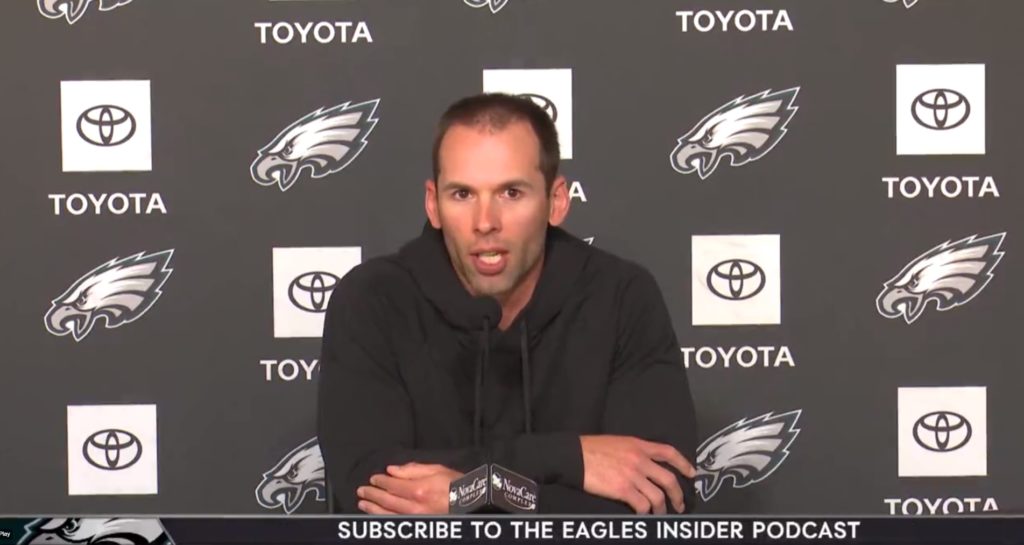Ad Disclosure
Jonathan Gannon Meets with Media After Uninspiring Week 9 Defensive Performance

The Eagles defense took the brunt of the blame for Sunday’s loss. They couldn’t get a stop when needed. Couldn’t get to Justin Herbert. Needed to have somebody step up and make a play and didn’t get that either.
So coordinator Jonathan Gannon answered questions Tuesday from the beat writers and touched on a variety of topics, among them:
Quarterbacks have completed 80% of their passes against you. What gives?
Yeah, that’s what the numbers say. We definitely have to get that completion percentage down and there’s a number of ways to do that.
It starts with us, as coaches, to detail out some things and change some looks. And rush and cover, cover and rush have to get a little bit better.
But when you’re playing good quarterbacks with good skilled people – we played well at times, but probably not consistent enough. So, that number has to come down. We have to improve that with our pass defense to be able to provide some resistance to good offenses.
But, ultimately, it’s about all of us just improving and being a little more consistent.
You’ve got Steven Nelson and Big Play Slay. What’s your apprehension with press man coverage?
We do play press a little bit. And there are certain spots that we would like to tighten up. And that comes down to me, calling it to get tighter.
But we feel good about those guys in the backend, to either play off or press, and some of that goes into the call. Some of that goes into the situation in the game.
So we just got to do a little bit better job, myself, of calling it a little bit better of when we need to get tight, get tight.
You blitzed more, but not on the last two drives. What’s the deal?
They caught a couple of pressures into some runs. But, when you look at it in passing situations, what they were doing, they were not going to let us hit the quarterback.
So, you saw, like, double chips. You saw some six, seven-man protections. So, typically when you see that as a defense, you devote more to coverage. You put more in coverage knowing that pressures aren’t going to get home and you’re kind of leaving your cover guys out to dry.
I think, though, I can set it up a little bit better when teams are doing that, just be a little more creative how we are aligning our pieces and what we are doing to generate more pressure, so teams can’t say, ‘Hey, this is what we’re going to do so you have to play a certain way.’
I think that I can – we can be a little more – we can dictate a little bit more just with the plan, how we set that up to where teams can’t always dictate that.
Why did you get rid of Eric Wilson?
A combination of kind of the guys that are playing well right now that we have playing. I think that that’s really the major reason.
It’s not so much what Eric didn’t do, it’s what other guys did do. And we feel like the guys that we have right now that are playing, or that are backing up those spots, can play winning football for us.
Can you show different things pre-snap to change how the offense is coming at you?
You can. But, when you do that, we always – you know, ‘What is this look, this look with this call, what do you want to show?’
And then you got to go through all the formations, and where people are, and different things like that. And without getting your guys – you know, a lot of people – here’s a good one, like, there’s – way back when, when you’re studying different disguises and things, right, a team – we did it at Minnesota – a team that has a safety on the line of scrimmage, well he plays in a deep post after the ball is snapped. And I always thought to myself – I got this from the players, they would say, ‘JG, that’s all cool and everything, but I have no shot to make any play in the middle of the field because I’m coming from the line of scrimmage. So, the disguise is great, but you’re really hamstringing me to be able to make plays.’
So, there’s a blend of how much you can tilt the coverage and disguise and make it look really different on the quarterback pre- and post-snap with also getting your guys in position to get what they need to get done within the call.
And like everything, there’s a blend to that. When can we be really aggressive with how we’re aligning people and when we really can’t?
Like, ‘This guy has three vertical and he’s on the line of scrimmage, and this guy is flexed out, hash plus two, like, good luck.’
So, that’s always an ever-evolving thing. And, with situationally, where can you take those chances, so to speak, to align people in certain ways.
Kevin has been writing about Philadelphia sports since 2009. He spent seven years in the CBS 3 sports department and started with the Union during the team's 2010 inaugural season. He went to the academic powerhouses of Boyertown High School and West Virginia University. email - k.kinkead@sportradar.com